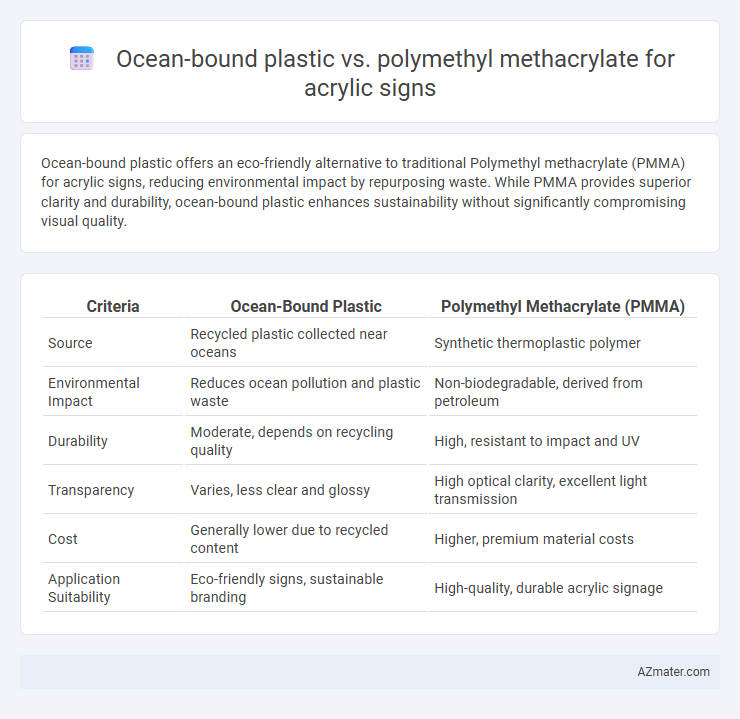Ocean-bound plastic offers an eco-friendly alternative to traditional Polymethyl methacrylate (PMMA) for acrylic signs, reducing environmental impact by repurposing waste. While PMMA provides superior clarity and durability, ocean-bound plastic enhances sustainability without significantly compromising visual quality.
Table of Comparison
| Criteria | Ocean-Bound Plastic | Polymethyl Methacrylate (PMMA) |
|---|---|---|
| Source | Recycled plastic collected near oceans | Synthetic thermoplastic polymer |
| Environmental Impact | Reduces ocean pollution and plastic waste | Non-biodegradable, derived from petroleum |
| Durability | Moderate, depends on recycling quality | High, resistant to impact and UV |
| Transparency | Varies, less clear and glossy | High optical clarity, excellent light transmission |
| Cost | Generally lower due to recycled content | Higher, premium material costs |
| Application Suitability | Eco-friendly signs, sustainable branding | High-quality, durable acrylic signage |
Introduction to Acrylic Signs: Materials Matter
Acrylic signs are commonly fabricated using polymethyl methacrylate (PMMA), a durable and lightweight plastic known for its clarity and weather resistance. Ocean-bound plastic is an emerging sustainable alternative, sourced from recovered waste that prevents pollution of marine environments while offering eco-friendly signage options. Comparing both, PMMA provides superior optical quality and longevity, whereas ocean-bound plastics emphasize environmental impact reduction without compromising basic functionality.
Understanding Ocean-Bound Plastic: Definition and Sources
Ocean-bound plastic refers to plastic waste collected near coastlines before it enters marine environments, primarily originating from mismanaged land-based sources such as rivers, beaches, and urban runoff. This type of plastic is often recovered from high-risk zones within 50 kilometers of shorelines, preventing environmental damage and supporting circular economy initiatives. Polymethyl methacrylate (PMMA), commonly used for acrylic signs, offers durability and clarity but contrasts with ocean-bound plastic, which emphasizes sustainability and environmental responsibility in material sourcing.
What is Polymethyl Methacrylate (PMMA)?
Polymethyl Methacrylate (PMMA) is a transparent thermoplastic often used as a lightweight and shatter-resistant alternative to glass in acrylic signs. Known for its excellent optical clarity, weather resistance, and UV stability, PMMA provides durability and vibrant color retention, making it ideal for long-lasting signage applications. Unlike ocean-bound plastic, which is recycled marine waste repurposed for sustainable products, PMMA is a synthetic polymer produced through chemical synthesis, offering superior strength and design flexibility.
Environmental Impact: Ocean-Bound Plastic vs PMMA
Ocean-bound plastic significantly reduces marine pollution by repurposing waste destined for oceans, cutting carbon emissions and saving non-renewable resources. Polymethyl methacrylate (PMMA), while durable and clear, is derived from petroleum, contributing to fossil fuel depletion and environmental toxicity during production and disposal. Choosing ocean-bound plastic for acrylic signs promotes sustainability by diverting plastic waste from ecosystems and minimizing the ecological footprint compared to conventional PMMA materials.
Durability and Performance: Comparing Material Strength
Ocean-bound plastic, derived from recycled marine waste, offers moderate durability with resistance to weathering but can degrade faster under prolonged UV exposure compared to Polymethyl methacrylate (PMMA). PMMA, known for superior impact resistance and long-lasting clarity, maintains structural integrity and vibrant appearance over time, making it ideal for high-performance acrylic signs. In terms of material strength, PMMA consistently outperforms ocean-bound plastic by delivering enhanced scratch resistance, rigidity, and longevity in diverse environmental conditions.
Visual Clarity and Aesthetic Quality
Ocean-bound plastic offers a sustainable alternative for acrylic signs but often compromises visual clarity due to inherent impurities and color variations, which can affect the overall aesthetic quality. Polymethyl methacrylate (PMMA) provides superior transparency and consistent optical properties, ensuring crisp, vibrant visuals and a high-gloss finish that enhances sign appeal. The choice between these materials balances environmental impact against premium clarity and aesthetic excellence, with PMMA remaining the industry standard for clarity-intensive applications.
Cost-Effectiveness and Availability
Ocean-bound plastic offers a cost-effective alternative for acrylic sign production, leveraging recycled materials that reduce raw material expenses and environmental impact. Polymethyl methacrylate (PMMA) provides consistent quality and durability but typically comes at a higher cost due to its synthetic production process. Availability of ocean-bound plastic depends on local recycling infrastructure, while PMMA is widely available globally through industrial suppliers.
Recyclability and End-of-Life Considerations
Ocean-bound plastic used for acrylic signs offers enhanced environmental benefits through its potential for recycling and reducing marine pollution, yet it often faces challenges in material consistency and recycling infrastructure. Polymethyl methacrylate (PMMA), widely recognized for its durability and clarity, provides well-established recyclable pathways but requires controlled facilities to ensure effective end-of-life processing. Evaluating recyclability of these materials highlights ocean-bound plastic's contribution to circular economy models while PMMA's recyclability relies on specialized industrial recycling methods to prevent landfill accumulation.
Applications and Use Cases in Signage
Ocean-bound plastic is an eco-friendly material increasingly used in sustainable acrylic signage, demonstrating strong durability and resistance to environmental factors ideal for outdoor advertising and informational displays. Polymethyl methacrylate (PMMA), renowned for its clarity, UV resistance, and weather stability, remains a top choice for high-quality, visually striking acrylic signs in retail, corporate, and directional signage. While ocean-bound plastic emphasizes environmental responsibility in signage production, PMMA offers superior optical properties and design flexibility critical for brand visibility and long-term outdoor use.
Choosing the Right Material: Key Considerations for Acrylic Signs
Ocean-bound plastic offers an eco-friendly option for acrylic signs by diverting waste from marine environments, enhancing sustainability in signage. Polymethyl methacrylate (PMMA) provides superior clarity, weather resistance, and durability, making it ideal for high-quality, long-lasting acrylic signs. Choosing the right material depends on balancing environmental impact, performance requirements, and budget constraints to achieve the desired sign functionality and aesthetics.

Infographic: Ocean-bound plastic vs Polymethyl methacrylate for Acrylic sign
 azmater.com
azmater.com